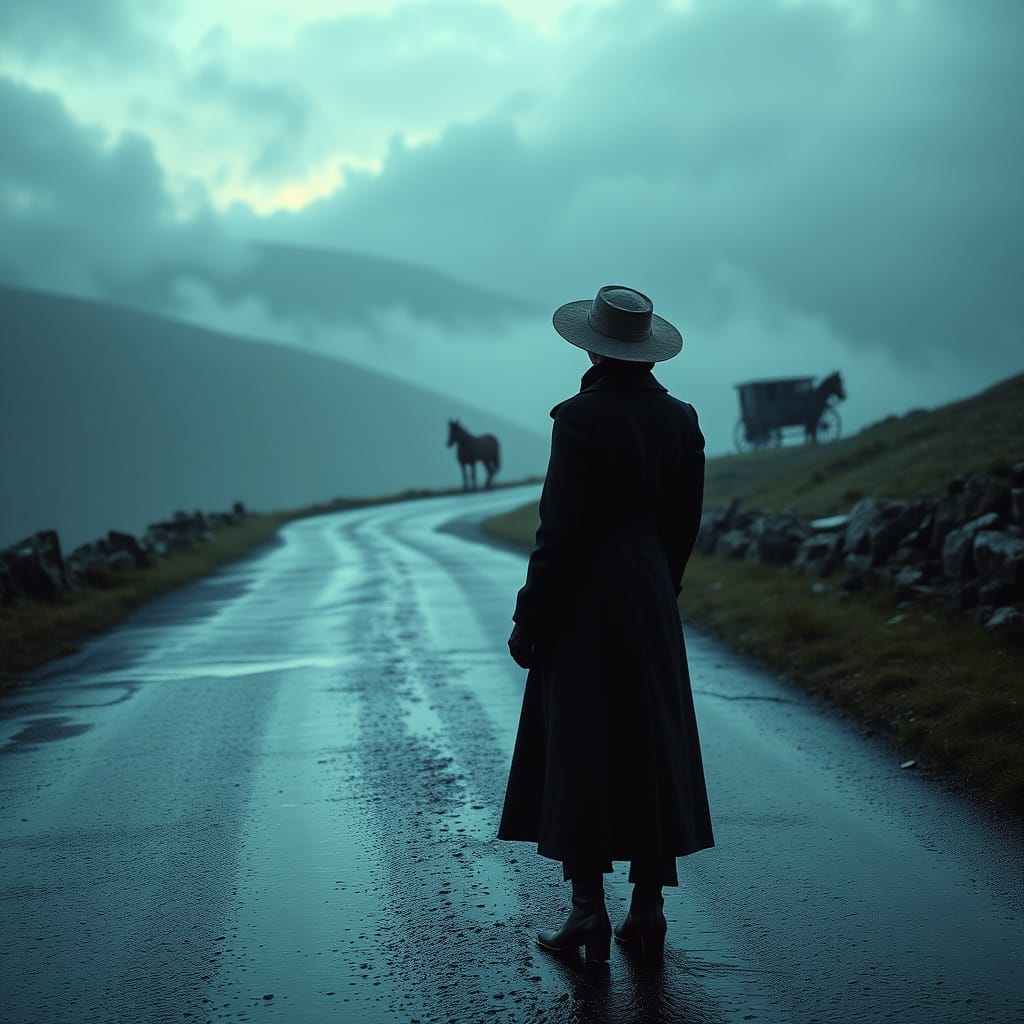At Castle Boterel
Thomas Hardy
1840 to 1928

As I drive to the junction of lane and highway,
And the drizzle bedrenches the waggonette,
I look behind at the fading byway,
And see on its slope, now glistening wet,
Distinctly yet
Myself and a girlish form benighted
In dry March weather. We climb the road
Beside a chaise. We had just alighted
To ease the sturdy pony’s load
When he sighed and slowed.
What we did as we climbed, and what we talked of
Matters not much, nor to what it led, –
Something that life will not be balked of
Without rude reason till hope is dead,
And feeling fled.
It filled but a minute. But was there ever
A time of such quality, since or before,
In that hill’s story? To one mind never,
Though it has been climbed, foot-swift, foot-sore,
By thousands more.
Primaeval rocks form the road’s steep border,
And much have they faced there, first and last,
Of the transitory in Earth’s long order;
But what they record in colour and cast
Is – that we two passed.
And to me, though Time’s unflinching rigour,
In mindless rote, has ruled from sight
The substance now, one phantom figure
Remains on the slope, as when that night
Saw us alight.
I look and see it there, shrinking, shrinking,
I look back at it amid the rain
For the very last time; for my sand is sinking,
And I shall traverse old love’s domain
Never again.
March 1913
Thomas Hardy's At Castle Boterel
The rain-streaked windshield becomes a window to the past in Thomas Hardy's "At Castle Boterel." As the speaker journeys towards an uncertain future, he's drawn back to a fleeting moment of love etched against the backdrop of the Dorset landscape. This poignant reflection on time, memory, and loss resonates with a particular intensity in our modern world, where the search for meaning and connection amidst constant change feels more urgent than ever.
Hardy's poem, written in 1913, emerges from a time of shifting social and intellectual currents. The Victorian era's certainties were fading, replaced by anxieties about industrialization and the erosion of traditional faith. Yet, despite its specific historical context, the poem speaks to universal human experiences that transcend any particular era. The speaker's longing for a lost love, the shrinking figure in the rain-blurred distance, mirrors our own yearning for those moments that shape us, even as time carries us relentlessly forward.
The poem's structure itself reinforces this sense of time's passage. The seven stanzas, with their steady ABABC rhyme scheme, create an almost inexorable forward momentum. Like the speaker's journey, the poem progresses with a measured inevitability, each line leading to the next, culminating in the finality of "Never again." Yet, within this structure, the enjambment, the spilling over of thoughts from one line to the next, suggests the fluidity of memory, the way the past can intrude upon the present.
Hardy masterfully uses sound and rhythm to evoke a mood of melancholic reflection. The very words—"drizzle," "bedrenches," "shrinking"—carry a weight of sadness and loss. Imagine a musical setting where a cello's somber notes mirror the speaker's grief, where the tempo slows to a crawl as he fixates on that "phantom figure" in the distance. The repetition of phrases like "I look and see it there" could become a haunting refrain, underscoring the speaker's obsession with the past.
But what makes this poem so powerful for the modern reader? Perhaps it's the way it captures the bittersweet nature of memory, particularly for those navigating life transitions. Retirement, career changes, the "empty nest" – these are times when we often find ourselves looking back, evaluating the choices that have shaped our lives. The speaker's journey to "old love's domain" becomes a metaphor for our own journeys through the landscapes of our past.
In a world where traditional sources of meaning are often questioned, "At Castle Boterel" speaks to our secular search for purpose. The speaker finds no solace in religious pronouncements, but rather in the enduring power of a shared human experience. That "minute" of intense connection, however fleeting, becomes a source of meaning that transcends the "unflinching rigour" of time. It reminds us that our lives are not merely a series of fleeting moments, but a tapestry woven from experiences that shape our identity and give our lives significance.
How can we apply this wisdom to our own lives? Perhaps the poem encourages us to cherish those moments of intense connection, to recognize their power to sustain us even in the face of loss. It invites us to ask ourselves: What are the "Castle Boterels" of our own lives? What past experiences continue to shape our present? How can we find meaning and purpose in the face of life's inevitable changes?
The poem's power lies in its ability to foster connection. Imagine a book club discussion where individuals share their own "Castle Boterel" moments, where the poem becomes a catalyst for exploring shared human experiences. Or picture a musical performance where the audience is enveloped in the sounds of longing and remembrance, where the shared experience of listening creates a sense of community.
"At Castle Boterel" is more than just a poem about lost love; it's a meditation on time, memory, and the search for meaning in a changing world. It reminds us that even as time marches on, the past continues to shape our present and inform our future. And in that recognition, perhaps, we can find a measure of solace and connection.
Create a Cloze Exercise
Click the button below to print a cloze exercise of the poem critique. This exercise is designed for classroom use.
